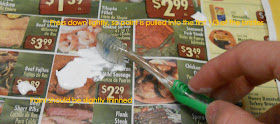Materials Needed:
- Any playing surface suitable for painting (I used a 3x3' 4mm MDF board)
- Black spray paint (Flat)
- Matte spray varnish
- Acrylic paints
- Scrap paper (should be heavy and thick, able to take paint without disintegrating)
- X-acto Knife
- 00 or 000 brush
- Old toothbrush
- Airbrush (you can use a spray can but it will require more complex masking)
- Circular objects of various diameters (dishes, lids, etc.)
1. Using the black spray paint, spray the entire playing surface. Make sure you use a good quality paint brand that will withstand regular gaming abuse and storage.
2. Mount the playing surface and protect the surrounding area from paint spatter. Pour some white paint unto the scrap paper and dilute it VERY slightly with water. Get some white paint on your old toothbrush, paint should wick about 1/3 the way up the bristles. Do not overload the toothbrush with paint!
Note: Use an old toothbrush that still has stiffness on the bristles (see pic below) or the effect will be harder to achieve when you "flick" the paint in the next step.
3. Hold the toothbrush as pictured below. Apply very slight downward pressure on the bristles with your thumb.
4. Starting in one corner, hold the brush 4-8" from the surface and pull back on the bristles. This will "flick" the paint unto the surface as tiny specks. Hold the brush closer for larger specks and denser fields, further away for smaller specks and more diffuse fields. Do this to the entire board.
5. Pick out smaller stars with an 00 brush and by mixing different colors with the paint. Blue, yellow and orange are good choices.
6. You now have a simple starfield in 5-10 minutes.
7. Using your scrap paper, cut circular stencils of various sizes with common household objects (I'm using an overturned bowl below).
Note: If you are using spraypaint instead of an airbrush, you will have to use more scrap paper and smaller stencils. Be sure to mask any area you do not want paint on! Spray cans are under high pressure and will spray pigment far and wide.
8. Tape or hold the stencil tight to the surface and spray the first (darkest) coat of paint inside the planet stencil. Hold your airbrush further away in this step to guarantee a crisp, clean outline. Be aware of overspray.
9. Establish one corner of the surface as your planetary system's star direction. Still holding the stencil tight, apply progressively lighter shades of the base color in crescent-shaped patterns, with their middle towards the star's direction (see pic below).
10. If you want your planet to have gas or cloud streams, apply these in the same way, but in a generally perpendicular pattern to the surface. The clouds should be lighter on the planetside facing the system's star.
11. Continue these same techniques for other planets and their moons. Moons should have a slight to severe overlap of the "parent" planet but should not be completely centered on that planet.
12. Once all planets and moons are complete, using your 00 brush and white paint, outline the curve closest to the system's star to mimic zenithal lighting.
13. Seal your play surface with matte varnish.














very cool tutorial, makes me want a game of bfg
ReplyDeleteI agree, very nice board.
ReplyDeleteNow I have a hankering to break out my BFG stuff...
Nice work, and thanks for showing the steps. The planets in particular are quite nice.
ReplyDeleteI went a different way with my board, but then again, yours is much more cost effective and versitile!
Your super good work deserves more recognition.
ReplyDeleteFor what it's worth, I nominated you for a Liebster Award. :)
http://lostdamnedstunted.blogspot.com/2014/05/liebster-award.html
This comment has been removed by a blog administrator.
ReplyDeleteGreat Tutorial. I have seen street painters videos doing the same thing, only reverse. They paint the planets first as a larger colored cloud and place the mask (a used pan cover) over where the planet will be and spray the space portions.
ReplyDelete